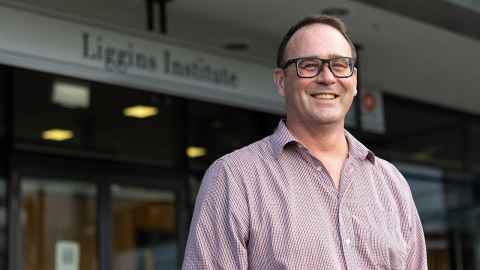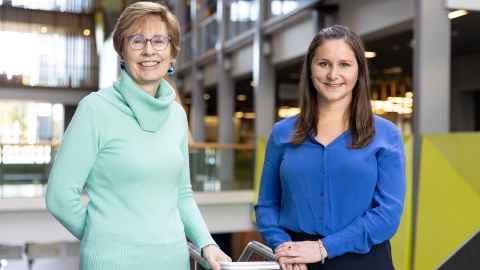Harnessing technology to improve babies' well-being
28 October 2022
Researchers from the University of Auckland’s Liggins Institute are about to harness the technology of rapid genome sequencing in the hope of improving the well-being of critically ill newborn babies. Story by Donna Chisholm

It took scientists 13 years and $US300 million to sequence the human genome. Twenty years on, the process, which now takes mere hours and costs just $1,000, is about to be used here in research benefiting the lives of dozens of babies born with rare and difficult-to-diagnose genetic diseases.
Liggins Institute deputy director Professor Justin O’Sullivan is heading efforts to launch rapid genomic sequencing for newborns in New Zealand, in a research project that will begin in 2023 and ultimately lead to the technique becoming common clinical practice. It’s already increasingly used in leading hospitals in Australia, the United States, Germany and Great Britain.
The technique was used on a baby born here in 2021, but the DNA samples were sequenced in Australia. Although in that case the child could not be saved, Justin and Liggins director Professor Frank Bloomfield, who published a case report on the child’s care, say the diagnosis provided certainty in a highly stressful situation, meaning doctors could avoid unnecessary medical procedures and the parents could spend as much time with their daughter as possible.
Donors backing the work include the Dines Family Charitable Trust, which has committed $1 million in addition to its support for other research across the University, at the Liggins Institute, Auckland Bioengineering Institute and Faculty of Engineering.
“We already know we can do it,” says Justin. “The issue is simply one of demonstrating that rapid genomic sequencing is going to work and that it has an economic and social impact.”

I think we put DNA on this pedestal: ‘Oh we have to be very careful about our
DNA’, and yet we leave it everywhere, absolutely everywhere. It’s on every coffee cup.
It’s estimated that about 6 percent of the babies in intensive care at any one time – roughly 12 children – will have one of the 7,000 genetic conditions doctors currently know about. Some American estimates range up to 15 percent, Justin says. The children are often desperately ill but the cause of their illness can be baffling. Sometimes, the disorder will prevent the baby metabolising nutrients such as protein and fat, causing them to steadily deteriorate after birth.
In one case recently diagnosed in the United States, a critically ill baby was discovered to have infantile encephalopathy linked to a genetic form of epilepsy and the disease was readily treated with biotin and thiamine. The child stopped seizing within days and, now seven months old, hasn’t had a seizure since.
“The quicker you can treat them, the less damage,” Justin says.
The Liggins Institute has ordered two state-of-the-art PromethION machines to sequence about 500 genomes from around 170 babies and their parents for the research project, which will cost $6-7 million over the next five years. Justin is in the process of applying for ethics committee approval for the study.
Given the extent of the information the tests will provide on risk for other diseases, ethical considerations and the support of genetic counselling will be vital.
The sequencing could reveal genetic variants linked to a number of cancers, as well as the heightened risk of a raft of conditions, some of which are untreatable. Parents will be asked if they want to know about any incidental findings and Justin says the study’s collaborators will ensure the proper handling and governance of the samples, in a way that recognises and provides for tikanga Māori.
We already know we can do it. The issue is simply one of demonstrating that rapid genomic sequencing is going to work and that it has an economic and social impact.
The project is one of two arms of new University of Auckland research to improve outcomes for babies. The other, led by Dr Sian Williams of the Liggins Institute and Professor Sue Stott of the Faculty of Medical and Health Sciences, aims to bring forward diagnoses of cerebral palsy (CP), thanks to a $200,000 funding injection from the Cerebral Palsy Alliance Research Foundation.
About one baby in 500 is born with CP here – about 120 a year – but diagnoses aren’t usually made until children are, on average, 19 months old, because the signs often only become apparent if the child is unable to perform the expected complex motor functions.
Prematurity is associated with about half of cerebral palsy cases, but damage to the developing brain can also be caused or accelerated in the womb, during birth, or up until two years of age.
Sian says three reliable diagnostic tools – MRI, a general movements assessment, and the Hammersmith infant neurological examination – can accurately diagnose CP or predict babies at increased risk, from three months of age. Studies are increasingly showing that early intervention with physiotherapy and occupational therapy during this time of peak neuroplasticity can reduce long-term disability.
Sian and Sue led a 2021 study that showed only 21 percent of the 57 families who participated received a diagnosis before their child was six months old, despite 60 percent of them expressing concerns earlier about the baby’s movement. The CP Alliance money will support the pilot of an early diagnosis hub in the Wellington region which, if successful, could be launched nationally.

Cerebral palsy studies are increasingly showing that early intervention with physiotherapy and occupational therapy during the time of peak neuroplasticity can reduce long-term disability.
The introduction of rapid genomic sequencing comes 50 years after the pioneering work of Professor Sir Graham ‘Mont’ Liggins, after whom the Liggins Institute is named.
In a paper published in 1972, Sir Graham showed how antenatal steroid injections could mature the lungs of babies at risk of being born too early. The technique has since been introduced globally, saving tens of thousands of lives.
Justin acknowledges the latest technology might sound scary to some, but it is not.
“This is not new: genetic diagnosis is already here. We’re just trying to introduce a rapid whole genome-based approach inside the country that’s accessible. Yes, it is scary to some people, but I think we put DNA on this pedestal – ‘Oh we have to be very careful about our DNA’ – and yet, we leave it everywhere, absolutely everywhere. It’s on every coffee cup.”
Rapid sequencing is just the beginning, he says.
“If we get this running properly, the impacts are massive. Usually, the sooner you know you are at risk, the more likely it is that treatments will reduce or delay the effects, when the treatments exist.
“Over time, rapid sequencing will become more acceptable as a part of the healthcare system.”
So, what would Mont make of this latest advance? Justin never met Mont, who died in 2010, but hopes he’d be proud.
“I’d like to think he’d be really supportive. The beautiful work he did is the foundation of the Institute, which turns 21 this year. This is just a new technology that’s giving us the ability to help in a different way.”
This story is from the University of Auckland's alumni and friends publication Ingenio, Spring 2022 issue.